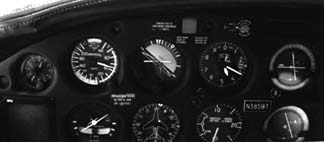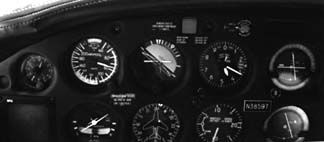
Staff Report
Train like you fight. Fight like you train. The warriors mantra certainly applies to the high-stakes game of instrument flight, where mistakes can be deadly and there is often no one there to bail you out.
But problems arise when realistic training is either unavailable or dangerous. In those cases, adopt the best simulations you can under the circumstances but prepare yourself for the real thing to be very different.
There are several areas where this situation arises in light aircraft. Spins and loss of vacuum instruments are two areas where training does a poor job of simulating the actual emergency conditions, but at least the training structure addresses the need to recognize the problem and prevent disaster.
The same cannot be said for unusual attitudes training and its companion, spatial disorientation. During training for a checkride, an instructor may maneuver aggressively to disorient the student pilot before the recovery, but a DPE is limited to 10 degrees of pitch and 45 degrees of bank. That same instructor giving recurrent training often backs off the maneuvers – sometimes to the point where the student is able to maintain equilibrium throughout the maneuver.
Even if the instructor succeeds in inducing disorientation, the training exercise lacks the insidious nature of a real-life encounter. Therein lies much of the problem of unusual attitude training. Like partial panel simulation, the nature of the emergency makes it difficult to simulate in airplanes, and the reaction among many flight instructors and students alike is to make a half-hearted pass – just enough to fulfill the letter of the law.
The Enemy Within
While many pilots think of episodes such as wake turbulence encounters when considering unusual attitudes, in fact an unusual attitude is any attitude that occurs inadvertently. It can result from turbulence, distraction, instrument failure, trim runaway, autopilot failure, inattention, spatial disorientation or even the delay in processing that occurs when you transition from visual flight to instrument flight.
Most of the time, these attitude diversions are mild and quickly brought under control by the pilot. However, lack of contrast between sky and ground or a missing horizon can lead to more troubling forays into the world of unexpected flight.
Climbing out on a night takeoff, for example, is troubling to some pilots when the nose of the airplane obscures the ground lights in front. The resulting disorientation is compounded by the combination of climb and acceleration.
Although the characteristics of the aircraft have some bearing on the dynamics of unusual attitudes, some principles to consider include the fact that you should immediately transition to instruments whenever you become disoriented, even in visual conditions, and make the appropriate crosschecks to ensure an instrument failure isnt whats getting you into trouble in the first place.
There may be sensory hints that the airplane is entering an unusual attitude – such as increased wind noise as airspeed increases or the engine laboring when a fixed-pitch prop slows down when nose is up – but dont count on them. While students may rely on the sound of power changes to help them recover during checkrides, a real-life encounter will not have the same indications.
Recognizing that the airplane is in an unusual attitude, then, comes in one of two forms – either a picture of an unusual attitude on the attitude indicator or abnormal performance indications on the performance instruments.
Regardless of how you initially detect the condition, verify that the unusual attitude exists by comparing the control and performance instrument indications before you initiate recovery. That way, you wont make an incorrect recovery based on a failed instrument or system.
If you have redundant attitude indicators, including copilot instruments, compare the two. If they agree, you can recover using the attitude indicator. If there is any doubt, however, recover using the procedures for inoperative attitude indicators.
Taming the Beast
Once you spot a problem, recovery can be relaxed or aggressive, depending on the severity of the attitude, the airplane involved, and the amount of altitude and airspeed margins available. If you remember nothing else, remember that eliminating bank in a dive aids in pitch control, use of a bank in climb aids pitch control, and power and drag devices aid airspeed control.
With those principles in mind, its possible to attend to some of the nuances involved. If the attitude indicator works, simply use the bank pointer as a sky pointer. It will always point up (unless the instrument has tumbled) and you simply need to roll toward the bank pointer to correct an inverted attitude.
In many instances, however, the attitude indicator may not be reliable. If the bank became extreme because of wake turbulence, for example, the gyro may have tumbled. If the attitude became unusual because of a vacuum system failure, then the gyro is certainly unreliable. This underscores the importance of crosschecking the artificial horizon with the other instruments.
Without the attitude indicators help, spatial disorientation may become severe. If you dont transition immediately to a partial panel recovery, the airplanes attitude may get more extreme and you may enter an unrecoverable situation.
With that in mind, its also important to make corrections smoothly, because yanking can be dangerous in turbulent conditions or if the airplane is near either the high-speed or the low-speed side of the airspeed envelope.
If the attitude indicator is inoperative or even suspect, recover using partial panel. A couple of snapshot glances at the panel will let you know if youre climbing or descending, or if your bank is becoming dangerous in some way.
Airspeed decreasing, VSI positive and altimeter increasing, of course, means the airplane is nose high. Apply power and begin to reduce pitch while you scan the turn coordinator and directional gyro. If they show a bank, consider letting the bank remain for a few seconds to help the nose to fall without inducing negative g forces by pushing the stick forward. When the airspeed stops its decline, reduce bank and recover to straight and level.
Airspeed increasing, VSI negative and altimeter decreasing means just the opposite. Reduce power immediately, but do not immediately pull the nose up. Scan quickly for bank and correct to wings level using the turn coordinator. Then begin to bring the nose up.
Pulling pitch before leveling the wings, youll recall, can result in steepening and tightening a spiral dive. Fight this instinct.
Once the airplane has begun to recover to straight and level, youre still not out of the woods. Passing through straight and level is common because the control inputs to recover from the unusual attitude are often high, and some pilots do not relax them in time. In addition, you may start trying to figure out why the deviation happened before youre fully recovered, which simply adds to the problem.
Generally speaking, the nose-down attitude is the most common and is due to the inherent tendency of airplanes to enter a spiral dive if left alone in level flight. Its also the most dangerous because speed can build quickly and pulling back too hard can invite structural failure.
The nose up attitude is generally caused by trim problems. If the trim motor or autopilot has malfunctioned, you may be forced to hold extreme forward pressure on the stick just to maintain level flight. However, if trim is not the source of the nose-up diversion, its easy to overcontrol and enter a spiral dive.
If you keep the airplane properly trimmed, keep the cockpit organized and cross-check efficiently, your chances of entering an unusual attitude are greatly reduced. But if it does happen, trust your eyes and your instruments rather than your other senses.
If your instrument skills are sharp, recovery shouldnt be a problem. If theyre not, and youre sure all is lost, you might want to punch on the autopilot as a last ditch effort to regain control.
Also With This Article
Click here to view “Recovery With and Without the Attitude Indicator.”




